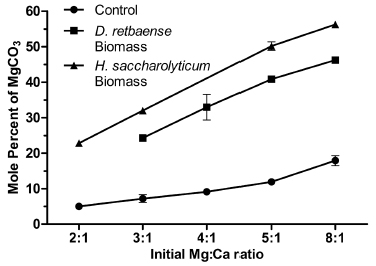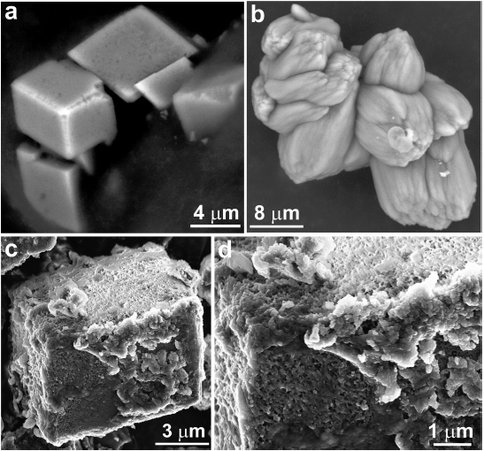2014 Annual Science Report
 University of Wisconsin
Reporting | SEP 2013 – DEC 2014
University of Wisconsin
Reporting | SEP 2013 – DEC 2014
Project 2A: The Catalysis Effect of Extracellular Polymeric Substances Excreted by Fermentative Bacteria on Ca-Mg Carbonate Precipitation
Project Summary
Experiments show that purified non-metabolizing biomass from pure cultures of both anaerobic fermenting and sulfate-reducing bacteria closely related to those organisms present in the consortium could also catalyze the precipitation of disordered dolomite. Polysaccharides that are the dominant components in the EPS act as catalysts for weakening surface water and Mg (II) boning and enhancing dolomite crystallization. Our study contributes to the understanding of the “dolomite problem” by revealing (1) the catalytic effect of bound EPS on Ca-Mg carbonate crystallization and (2) the possible involvement of anaerobic fermenting bacteria in sedimentary dolomite formation, which has not been reported previously.
Project Progress
Because of its rare occurrence in modern sediments, as well as the difficulty in synthesizing it under low-temperature conditions in the laboratory, the origin of sedimentary dolomite has remained a long-standing enigma, often referred to as the “dolomite problem.” Recently, anaerobic microorganisms, such as sulfate-reducing bacteria and methanogens, have been recognized for mediating dolomite precipitation. However, the exact role of microorganisms in dolomite crystallization is still under debate and the possible involvement of anaerobic fermenting bacteria has not been studied. In our early studies, we characterized the effect of purified non-metabolizing biomass and bound extracellular polymeric substances (EPS) of a natural consortium of anaerobic microorganisms dominated by fermenting bacteria and sulfate-reducing bacteria on Ca-Mg carbonate precipitation. Our data show that disordered dolomite, a precursor of some sedimentary stoichiometric ordered dolomite, can be precipitated in calcite-seeded Ca-Mg carbonate solutions containing purified non-metabolizing consortium biomass. Bound EPS extracted from the consortium culture were shown to be the active component that triggered the crystallization of disordered dolomite. Recent experiments show that purified non-metabolizing biomass from pure cultures of both anaerobic fermenting and sulfate-reducing bacteria closely related to those organisms present in the consortium could also catalyze the precipitation of disordered dolomite (Figs. 1, 2).

It is proposed that polysaccharides that are the dominant components in the EPS act as catalysts for lowering surface water and Mg (II) boning and enhance dolomite crystallization. Future ab initio simulations based on density functional theory (DFT) will be carried out in order to understand the catalytic roles of EPS in sedimentary dolomite crystallization.
This study defines a plausible role of anaerobic ferment¬ing bacteria in sedimentary dolomite formation, which to our best knowledge has not been reported previously. Unlike SRB, which are limited to environments with high concentrations of dissolved sulfate, the ubiquitous distribution of anaerobic fermenting bacteria in both freshwater and marine environments may extend the range of natural environments where microbial-induced dolomite precipitation could take place.
Publications
-
Zhang, F., Xu, H., Shelobolina, E. S., Konishi, H., Converse, B., Shen, Z., & Roden, E. E. (2015). The catalytic effect of bound extracellular polymeric substances excreted by anaerobic microorganisms on Ca-Mg carbonate precipitation: Implications for the “dolomite problem”. American Mineralogist, 100(2-3), 483–494. doi:10.2138/am-2015-4999
-
PROJECT INVESTIGATORS:
-
PROJECT MEMBERS:
Huifang Xu
Project Investigator
Eric Roden
Co-Investigator
Evgenya Shelobolina
Collaborator
Zhizhang Shen
Collaborator
Fangfu Zhang
Collaborator
-
RELATED OBJECTIVES:
Objective 7.1
Biosignatures to be sought in Solar System materials
Objective 7.2
Biosignatures to be sought in nearby planetary systems
